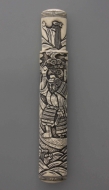Pipe holder from a series
January 2010

In Japan, the tobacco pipe, the kiseru, is stored in a case, the so-called kiseruzutsu. In addition to wood as a material, bone or stag horn is often used. This specimen is made of bone and consists of two sliding sleeves, the outside of which is extensively decorated. The scene shows a warrior in historical costume with a second figure in front of him, a fish in the water. We also see rocks, blooming flowers and a tree trunk. Part of the main show will extend on the cover section. Unfortunately we miss the meaning of this depiction. The carving is a bit scratchy and is then rubbed with black paint. There is no question of great artistic work, it is more the curio aspect that stands out. Interestingly, there is a series of six examples of this pipe holder that are very similar but all different. The set was purchased in 1888 by the Rijksmuseum voor Volkenkunde from a Leiden tradesman. The fact that the purchase took place over a 120 years ago is extremely unexpected. The kiseruzutsu developed a great refinement in Japan and at first sight these pieces would be labeled as 20th century souvenir pieces. However, the pedigree proves that it is different. The reason for the National Museum of Ethnology for deaccessioning these objects recently lies in their collection objective, but is not made public. For the Pijpenkabinet, they play a role in showing the variety of Japanese kiseruzutsus, although due to their lack of artistry they are certainly not the best examples.
Amsterdam Pipe Museum APM 20.088e
Archive object of month